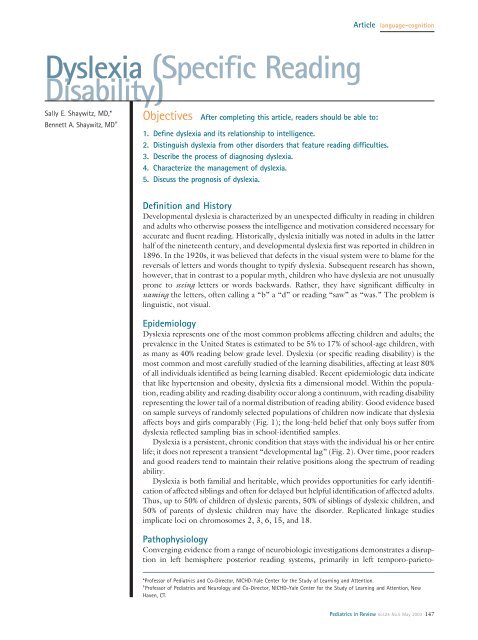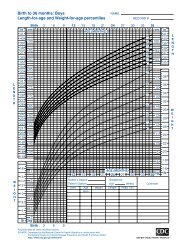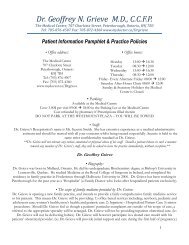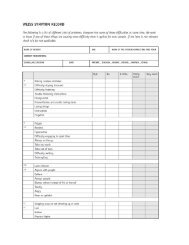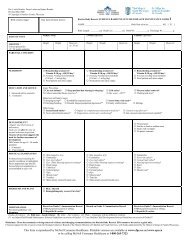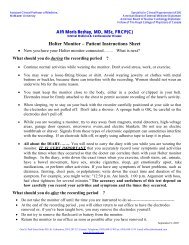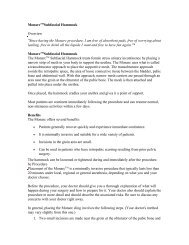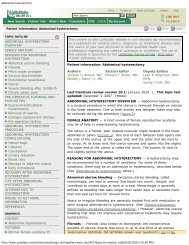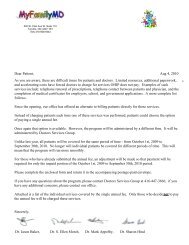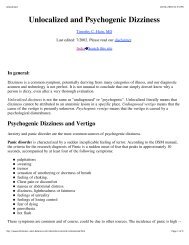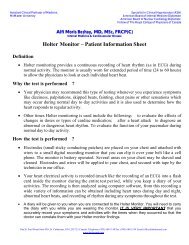Dyslexia (Specific Reading Disability) - Mydoctor.ca
Dyslexia (Specific Reading Disability) - Mydoctor.ca
Dyslexia (Specific Reading Disability) - Mydoctor.ca
Create successful ePaper yourself
Turn your PDF publications into a flip-book with our unique Google optimized e-Paper software.
Article language-cognition<strong>Dyslexia</strong> (<strong>Specific</strong> <strong>Reading</strong><strong>Disability</strong>)Sally E. Shaywitz, MD,*Bennett A. Shaywitz, MD †Objectives After completing this article, readers should be able to:1. Define dyslexia and its relationship to intelligence.2. Distinguish dyslexia from other disorders that feature reading difficulties.3. Describe the process of diagnosing dyslexia.4. Characterize the management of dyslexia.5. Discuss the prognosis of dyslexia.Definition and HistoryDevelopmental dyslexia is characterized by an unexpected difficulty in reading in childrenand adults who otherwise possess the intelligence and motivation considered necessary foraccurate and fluent reading. Histori<strong>ca</strong>lly, dyslexia initially was noted in adults in the latterhalf of the nineteenth century, and developmental dyslexia first was reported in children in1896. In the 1920s, it was believed that defects in the visual system were to blame for thereversals of letters and words thought to typify dyslexia. Subsequent research has shown,however, that in contrast to a popular myth, children who have dyslexia are not unusuallyprone to seeing letters or words backwards. Rather, they have signifi<strong>ca</strong>nt difficulty innaming the letters, often <strong>ca</strong>lling a “b” a “d” or reading “saw” as “was.” The problem islinguistic, not visual.Epidemiology<strong>Dyslexia</strong> represents one of the most common problems affecting children and adults; theprevalence in the United States is estimated to be 5% to 17% of school-age children, withas many as 40% reading below grade level. <strong>Dyslexia</strong> (or specific reading disability) is themost common and most <strong>ca</strong>refully studied of the learning disabilities, affecting at least 80%of all individuals identified as being learning disabled. Recent epidemiologic data indi<strong>ca</strong>tethat like hypertension and obesity, dyslexia fits a dimensional model. Within the population,reading ability and reading disability occur along a continuum, with reading disabilityrepresenting the lower tail of a normal distribution of reading ability. Good evidence basedon sample surveys of randomly selected populations of children now indi<strong>ca</strong>te that dyslexiaaffects boys and girls comparably (Fig. 1); the long-held belief that only boys suffer fromdyslexia reflected sampling bias in school-identified samples.<strong>Dyslexia</strong> is a persistent, chronic condition that stays with the individual his or her entirelife; it does not represent a transient “developmental lag” (Fig. 2). Over time, poor readersand good readers tend to maintain their relative positions along the spectrum of readingability.<strong>Dyslexia</strong> is both familial and heritable, which provides opportunities for early identifi<strong>ca</strong>tionof affected siblings and often for delayed but helpful identifi<strong>ca</strong>tion of affected adults.Thus, up to 50% of children of dyslexic parents, 50% of siblings of dyslexic children, and50% of parents of dyslexic children may have the disorder. Repli<strong>ca</strong>ted linkage studiesimpli<strong>ca</strong>te loci on chromosomes 2, 3, 6, 15, and 18.PathophysiologyConverging evidence from a range of neurobiologic investigations demonstrates a disruptionin left hemisphere posterior reading systems, primarily in left temporo-parieto-*Professor of Pediatrics and Co-Director, NICHD-Yale Center for the Study of Learning and Attention.† Professor of Pediatrics and Neurology and Co-Director, NICHD-Yale Center for the Study of Learning and Attention, NewHaven, CT.Pediatrics in Review Vol.24 No.5 May 2003 147
language-cognitiondyslexiaFigure 1. Prevalence of reading disability in research-identified (RI) and school-identified(SI) boys and girls. Schools identify about four times as many boys as girls, reflectingprimarily externalizing behavioral characteristics that are more likely to bring boys to ateacher’s attention. This skewed prevalence rate reflects referral bias, and when actualreading scores are used to identify children, there is no signifi<strong>ca</strong>nt difference in theprevalence of dyslexia between boys and girls. Data adapted from Shaywitz, Shaywitz,Fletcher, and Escobar, 1990. Copyright © 2002, S. Shaywitz.occipital brain regions, in dyslexic readers, with a relativeincrease in brain activation in frontal regions in dyslexiccompared with nonimpaired readers (Fig. 3). These neuralsystems are part of a widely distributed neural systemrelating spoken language to the written word.These neurobiologic data are consistent with a strongconsensus among investigators in the field that the centraldifficulty in dyslexia reflects a deficit within thelanguage system, although other systems and processesmay contribute to the difficulty. The language system isconceptualized as a hierarchi<strong>ca</strong>l series of components. Athigher levels are neural systems engaged in processing,for example, semantics, syntax, and discourse. At thelowest level is the phonologic module dedi<strong>ca</strong>ted to processingthe distinctive sound elements that constitutelanguage. The functional unit of the phonologic moduleis the phoneme, defined as the smallest discernible segmentof speech. For example, the word “bat” consists ofthree phonemes: /b/ /ae/ /t/. To speak a word, thespeaker retrieves the word’s phonemic constituents fromhis or her internal lexicon, assembles the phonemes,and utters the word. Conversely, to read a word, thebeginning reader initially must divide the word into itsunderlying phonemes. Phonemi<strong>ca</strong>wareness—the insight that all spokenwords <strong>ca</strong>n be pulled apart intophonemes—is deficient in childrenand adults who have dyslexia. Resultsfrom large and well-studiedpopulations that have reading disabilityconfirm that a deficit in phonologyrepresents the most robustand specific correlate of reading disabilityin young school-age childrenand adolescents.Basi<strong>ca</strong>lly, reading comprises twoprimary processes: decoding andcomprehension. In dyslexia, a deficitat the level of the phonologicmodule impairs the ability to segmentthe written word into its underlyingphonologic elements. As aresult, the reader experiences difficultyin decoding and identifyingthe printed word. The phonologicdeficit is domain-specific; that is, itis independent of other, nonphonologiclinguistic abilities. In particular,the higher-order cognitiveand linguistic functions involved incomprehension, such as general intelligenceand reasoning, vo<strong>ca</strong>bulary, and syntax, areintact. The pattern of a deficit in phonologic analysiscontrasted with intact higher-order cognitive abilitiesoffers an explanation for the paradox of otherwise intelligentpeople who experience great difficulty in reading.According to the model, a circumscribed deficit in alower-order linguistic (phonologic) function blocks accessto higher-order processes and to the ability to drawmeaning from text. The affected reader <strong>ca</strong>nnot use his orher higher-order linguistic skills to access the meaninguntil the printed word has been decoded and identified.For example, an individual who knows the precise meaningof the spoken word “apparition” will not be able touse that knowledge of the meaning of the word until heor she <strong>ca</strong>n decode and identify the printed word on thepage, thereby appearing not to know the word’s meaning.DiagnosisAt all ages, dyslexia is a clini<strong>ca</strong>l diagnosis. The clinicianseeks to determine through history, observation, andpsychometric assessment, if there are: 1) unexpecteddifficulties in reading (ie, difficulties in reading that are148 Pediatrics in Review Vol.24 No.5 May 2003
language-cognitiondyslexiaFigure 2. Trajectory of reading skills over time in nonimpaired and dyslexic readers.Ordinate is Rasch scores (W scores) from the Woodcock-Johnson reading test (Woodcockand Johnson, 1989) and abscissa is age in years. Both dyslexic and nonimpaired readersimprove their reading scores as they get older, but the gap between the dyslexic andnonimpaired readers remains. Thus, dyslexia is a deficit, not a developmental lag. Dataadapted from Francis, Shaywitz, Stuebing, Shaywitz, and Fletcher, 1996.unexpected for the person’s cognitive <strong>ca</strong>pacity, as shownby his or her age, intelligence, or level of edu<strong>ca</strong>tion orprofessional status) and 2) associated linguistic problemsat the level of phonologic processing. No one single testscore is pathognomonic of dyslexia. As with any othermedi<strong>ca</strong>l diagnosis, the diagnosis of dyslexia should reflecta thoughtful synthesis of all available clini<strong>ca</strong>l data. <strong>Dyslexia</strong>is distinguished from other disorders that mayprominently feature reading difficulties by the unique,circumscribed nature of the phonologic deficit, whichdoes not intrude into other linguistic or cognitive domains.In the preschool-age child, a history of language delayor of not attending to the sounds of words (troubleplaying rhyming games with words, confusing words thatsound alike, trouble learning to recognize letters of thealphabet), along with a positive family history, representsignifi<strong>ca</strong>nt risk factors for dyslexia. In the school-agechild, presenting complaints most commonly center onschool performance (“She’s not doing well in school”),and often parents (and teachers) do not appreciate thatthe <strong>ca</strong>use is a reading difficulty. A typi<strong>ca</strong>l picture is a childwho may have had a delay in speaking, does not learnletters by kindergarten, and has not begun to learn toread by first grade. The child progressively falls behind,with teachers and parents puzzledas to why such an intelligent childhas difficulty learning to read. Thereading difficulty is unexpectedbased on the child’s ability, age, orgrade. Even after acquiring decodingskills, the child generally remainsa slow reader. Thus, brightdyslexic children may learn laboriouslyhow to read words accurately,but they do not become fluentreaders, recognizing words rapidlyand automati<strong>ca</strong>lly. Dysgraphia oftenis present and is accompaniedby laborious note-taking. Selfesteemfrequently is affected, particularlyif the disorder has goneundetected for a long period oftime.The level of edu<strong>ca</strong>tion or professionalstatus of an accomplished adolescentor young adult providesthe best indi<strong>ca</strong>tion of cognitive <strong>ca</strong>pacity;graduation from a competitivecollege and, for example, completionof medi<strong>ca</strong>l school and aresidency indi<strong>ca</strong>tes a superior cognitive <strong>ca</strong>pacity. Forbright adolescents and young adults, a history of phonologi<strong>ca</strong>llybased reading difficulties, requirements for extratime on tests, and current slow and effortful reading (ie,signs of a lack of automaticity in reading) are the sine quanon of a diagnosis of dyslexia. We emphasize that ahistory of phonologi<strong>ca</strong>lly based language difficulties, laboriousreading and writing, poor spelling, and the needfor additional time in reading and in taking tests providesindisputable evidence of a deficiency in phonologic processingthat, in turn, serves as the basis for, and thesignature of, a reading disability.Assessment of <strong>Reading</strong><strong>Reading</strong> is assessed by measuring decoding, fluency, andcomprehension. Among the currently available normedtests of phonologic analysis for young children is theComprehensive Test of Phonologi<strong>ca</strong>l Processing(CTOPP). It consists of measures of phonologic awareness,phonologic coding, and working memory as well asrapid naming. It has a national standardization for childrenranging in age from 5 years to adulthood. In theschool-age child, one important element of the evaluationis how accurately the child <strong>ca</strong>n decode words (ie,Pediatrics in Review Vol.24 No.5 May 2003 149
language-cognitiondyslexiaFigure 3. Schematic of brain activation maps in nonimpaired and dyslexic readersengaged in phonologic processing during the pseudoword rhyming test. Nonimpairedreaders activate: 1) an anterior system in the left inferior frontal region; 2) aparieto-temporal system involving the angular gyrus, supramarginal gyrus, and posteriorportions of the superior temporal gyrus; and 3) an occipito-temporal system involvingportions of the middle and inferior temporal gyrus and middle occipital gyrus. In contrast,dyslexic readers demonstrate a relative underactivation in both posterior systems and anincreased activation in the inferior frontal gyrus. Copyright © 2002, S. Shaywitz.read single words in isolation). This is measured withstandardized tests of single real word and pseudowordreading, such as the Woodcock-Johnson III and theWoodcock <strong>Reading</strong> Mastery Test. Difficulties oftenemerge on tests of spelling, which depend on these sameabilities. <strong>Reading</strong> fluency (reading connected text) isassessed by oral reading aloud, using the Gray Oral<strong>Reading</strong> Test. This test consists of 13 increasingly difficultpassages, each followed by five comprehension questions.Single-word reading efficiency may be assessed byusing the Test of Word <strong>Reading</strong> Efficiency (TOWRE), atest of speeded reading of individual words. For screeningby primary <strong>ca</strong>re physicians in the office, we recommendlistening to the child read aloud from his or herown grade level reader. Keeping a set of readers fromkindergarten through grade 4 available in the officeserves the same purpose and does not require the child tobring in schoolbooks. Oral reading is a very sensitivemeasure of reading accuracy and, even more importantly,of reading fluency.The most consistent and telling sign of a readingdisability in an accomplished young adult is slow andlaborious reading and writing. It must be emphasizedthat the failure either to recognize or to measure the lackof automaticity in reading is perhapsthe most common error in thediagnosis of dyslexia in older childrenand in accomplished youngadults. Simple word identifi<strong>ca</strong>tiontasks will not detect a person whohas dyslexia but is sufficiently accomplishedto be in honors highschool classes or to graduate fromcollege and attend law, medi<strong>ca</strong>l, orany other graduate school. Testsrelying on the accuracy of wordidentifi<strong>ca</strong>tion are inappropriate fordiagnosing dyslexia in accomplishedyoung adults be<strong>ca</strong>use theyreveal little of the person’s strugglesto read. It is important to recognizethat be<strong>ca</strong>use they assess readingaccuracy but not automaticity(speed), the reading tests commonlyused for school-age childrenmay provide misleading data onbright adolescents and youngadults. The most criti<strong>ca</strong>l tests arethose that are timed, which are themost sensitive to a phonologic deficitin a bright adult. However, veryfew standardized tests for young adult readers are administeredunder timed and untimed conditions, with theexception of the Nelson-Denny <strong>Reading</strong> Test. Anyscores obtained on testing must be considered relative topeers who have the same degree of edu<strong>ca</strong>tion or professionaltraining.Physi<strong>ca</strong>l and Neurologic Examination andLaboratory TestsA general physi<strong>ca</strong>l examination has a very limited role inthe evaluation of dyslexia. Primary sensory impairmentsshould be ruled out, particularly in young children. Inspecific instances, examination for the features of sexlinkedgenetic disorders, such as Klinefelter syndrome,that may be associated with language and reading problemsalso may be productive. Otherwise, the examinationshould be governed by any nondyslexic symptoms thatindi<strong>ca</strong>te specific areas of concern. Results of the routineneurologic examination usually are normal in childrenwho have dyslexia. Laboratory measures, such as imagingstudies, electroencephalography, or chromosomal analysis,are ordered only if there are specific clini<strong>ca</strong>l indi<strong>ca</strong>tions.At this time, functional imaging is restricted toresearch studies and is not used for clini<strong>ca</strong>l diagnosis.150 Pediatrics in Review Vol.24 No.5 May 2003
language-cognitiondyslexiaTreatmentThe management of dyslexia demands a lifespan perspective.Early in the child’s life, the focus is remediation ofthe reading problem. As a child matures and enters themore time-demanding setting of secondary school, theemphasis shifts to the important role of accommodations.The primary goal of effective intervention programsis to remediate the underlying problem in phonemi<strong>ca</strong>wareness, but all too frequently the standardinstruction provided through remediation is too little,too general, and too unsystematic. Most recently, basedon the work of the National <strong>Reading</strong> Panel, evidencebasedreading intervention programs have been identifiedthat provide instruction in the most important elementsof reading. Effective interventions used withyounger children and even with older children includeprograms to improve phonemic awareness (PA), which isthe ability to focus on and manipulate phonemes (speechIt is important to appreciate that phonologicdifficulties in dyslexia are independent ofintelligence.sounds) in spoken syllables and words. The elementsfound to be most effective in enhancing PA, reading, andspelling skills include teaching children to manipulatephonemes with letters, focusing the instruction on oneor two types of phoneme manipulations rather than onmultiple types, teaching children in small groups, andproviding systematic explicit instruction rather than incidentalinstruction. Providing instruction in PA is notsufficient to teach children to read. Effective interventionprograms encompass teaching phonics, that is, makingsure that the beginning reader understands how lettersare linked to sounds to form letter/sound correspondencesand spelling patterns. Also criti<strong>ca</strong>l to teachingphonics is explicit and systematic instruction. Phonicsinstruction enhances children’s success in learning toread, and systematic phonics instruction is more effectivethan “whole word” instruction, which teaches little or nophonics or teaches phonics haphazardly or in a “by-theway”approach.Fluency refers to the ability to read orally with speed,accuracy, and proper expression. Fluency is criti<strong>ca</strong>llyimportant be<strong>ca</strong>use it allows for the automatic, attentionfreerecognition of words, thus permitting these attentionalresources to be directed to comprehension. Althoughfluency is an important component of skilledreading, it often is neglected in the classroom. The mosteffective method to build reading fluency is guided repeatedoral reading, in which the child reads aloud repeatedlyto a teacher, an adult, or a peer and receivesfeedback. The evidence indi<strong>ca</strong>tes that guided oral readinghas a clear and positive impact on word recognition,fluency, and comprehension at many grade levels andapplies to both good readers and those experiencingreading difficulties. The evidence is less secure for programsfor struggling readers that encourage largeamounts of independent reading, that is, silent readingwithout any feedback to the student. Thus, even thoughindependent silent reading is intuitively appealing, theevidence at this time does not support its contribution toimproved reading fluency. No doubt there is a correlationbetween being a good readerand reading large amounts, butthere is a paucity of evidence for a<strong>ca</strong>usal relationship. In contrast toteaching phonemic awareness,phonics, and fluency, interventionsfor reading comprehension are notwell established. In large measurethis reflects the nature of the complexprocesses influencing readingcomprehension. The limited evidenceindi<strong>ca</strong>tes that the most effective methods to teachreading comprehension involve teaching vo<strong>ca</strong>bulary andteaching strategies that encourage active interaction betweenreader and text.Large-s<strong>ca</strong>le studies to date have focused on youngerchildren; as yet, few or no data are available on the effectof these training programs on older children. The managementof dyslexia for students in secondary school andespecially college and graduate school is primarily relatedto accommodation rather than remediation. High schooland college students who have a history of childhooddyslexia often present a paradoxic picture: they are similarto their unimpaired peers on measures of word recognition,but they continue to suffer from the phonologicdeficit that makes reading less automatic, more effortful,and slow. For readers who have dyslexia, extra time is anessential accommodation that allows them the time todecode each word and to apply their unimpaired higherordercognitive and linguistic skills to the surroundingcontext to determine the meaning of words that they<strong>ca</strong>nnot decode entirely or rapidly. Other helpful accommodationsinclude allowing the use of laptop computersPediatrics in Review Vol.24 No.5 May 2003 151
language-cognitiondyslexiawith spelling checkers, tape recorders in the classroom,recorded books (materials are available from Recordingfor the Blind and Dyslexic, www.rfbd.org), access tosyllabi and lecture notes, use of tutors to “talk through”and review the content of reading material, alternativesto multiple-choice tests (eg, reports or orally administeredtests), and a separate quiet room for taking tests.With such accommodations, many students who havedyslexia now are completing studies successfully in arange of disciplines, including medicine. It is importantto appreciate that phonologic difficulties in dyslexia areindependent of intelligence. Consequently, many highlyintelligent boys and girls have reading problems thatoften are overlooked and even ascribed to “lack of motivation.”When counseling patients who have dyslexia,pediatricians should bear in mind that at least two Nobellaureates, Niels Bohr and Barry Bennacerraf, were dyslexic.People who have dyslexia and their families frequentlyconsult their physicians about unconventional approachesto the remediation of reading difficulties. Ingeneral, very few credible data support the claims madefor these treatments (eg, optometric training, medi<strong>ca</strong>tionfor vestibular dysfunction, chiropractic manipulation,and dietary supplementation). Finally, pediatriciansshould be aware that no one “magic” program remediatesreading difficulties; a number of programs followingthe guidelines provided earlier have proven to be highlyeffective in teaching struggling children to read.Suggested <strong>Reading</strong>Francis DJ, Shaywitz SE, Stuebing KK, Shaywitz BA, Fletcher JM.Developmental lag versus deficit models of reading disability: alongitudinal, individual growth curves analysis. J Educ Psychol.1996;88:3–17Report of the National <strong>Reading</strong> Panel. Teaching Children to Read:An Evidence Based Assessment of the Scientific Research Literatureon <strong>Reading</strong> and its Impli<strong>ca</strong>tions for <strong>Reading</strong> Instruction.NIH Pub. No. 00-4754. Washington, DC: US Department ofHealth and Human Services, Public Health Service, NationalInstitutes of Health, National Institute of Child Health andHuman Development; 2000Shaywitz S. Current concepts: dyslexia. N Engl J Med. 1998;338:307–312Shaywitz S. Overcoming <strong>Dyslexia</strong>: A New and Complete Science-Based Program for <strong>Reading</strong> Problems at Any Level. New York,NY: Alfred A. Knopf; 2003Shaywitz SE. <strong>Dyslexia</strong>. Scientific Ameri<strong>ca</strong>n. 1996;275:98–104Shaywitz SE, Fletcher JM, Holahan JM, et al. Persistence of dyslexia:The Connecticut Longitudinal Study at Adolescence.Pediatrics. 1999;104:1351–1359Shaywitz SE, Shaywitz BA, Fletcher JM, Escobar MD. Prevalenceof reading disability in boys and girls: results of the ConnecticutLongitudinal Study. JAMA. 1990;264:998–1002Shaywitz SE, Shaywitz BA, Pugh KR, et al. Functional disruption inthe organization of the brain for reading in dyslexia. Proc NatlA<strong>ca</strong>d Sci USA. 1998;95:2636–2641Woodcock RW, McGrew KS, Mather N. Woodcock-Johnson III.Itas<strong>ca</strong>, Ill: Riverside; 2001152 Pediatrics in Review Vol.24 No.5 May 2003
language-cognitiondyslexiaPIR QuizQuiz also available online at www.pedsinreview.org.1. According to current theories, dyslexia is most likely the result of a defect in:A. General intelligence.B. Phonemic awareness.C. Problem-solving.D. Visual-motor coordination.E. Vo<strong>ca</strong>bulary acquisition.2. A 16-year-old high school junior does very well in daily classwork and grasps concepts well, oftenexplaining complex ideas to his classmates. Yet, he performs poorly on written tests, which he usually doesnot complete. Among the following, the most likely reason for his poor test scores is:A. Decreased motivation.B. Drug or alcohol abuse.C. Lack of reading fluency.D. Mood disorder.E. Visual-auditory dysfunction.3. Among the following, the most useful intervention for the patient described in the previous question is:A. Less challenging courses.B. More time to take tests.C. Optometric training.D. Psychiatric intervention.E. Toxicology screening.4. Among the following, the best method for building reading fluency is:A. Guided repeated oral reading.B. Independent silent reading.C. Listening to recorded books.D. Reader-text interaction.E. Vo<strong>ca</strong>bulary drill.Pediatrics in Review Vol.24 No.5 May 2003 153


